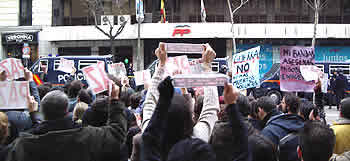In 1995 the RCMP and a group of Natives had a confrontation at Gustafson Lake in British Columbia. A friend of mine told me that the RCMP and Canadian Military used, (among other excessively forceful means), land mines against the Natives. I told him that because of International Law I didn’t believe that the Canadian Military would do such a thing. I explained that it sounded like nothing more than a conspiracy theory. However, he got my curiosity up and after a little bit of research on this topic I came up with the following:
First off the report from a First Nations Website:
“GUSTAFSEN LAKE in British Columbia represents just one more symbol that federal and provincial officials are denying the legitimate claims of Indigenous peoples whose title to the land was never extnguished by treaty. […] The armed conflict reportedly started when a group of cowboys threatened a Shuswap spiritual leader, calling him a “red nigger.” The federal RCMP has now escalated it to include use of the Army’s Bison Armored Personnel Carriers and land mines. This is an unacceptable militarization of a dispute over religious access to sacred land.” (Emphasis mine)
When I read this, I found it very hard to believe. Was it possible that land mines were used in Canada, in 1995? I found another site that reiterated this idea:
Although the Canadian government is enjoying wide acclaim for what appears to be a principled and vigorous opposition to the use of mines, Canada itself employed the weapon against Indigenous traditionalists defending sacred burial and Sundance grounds at Gustafsen Lake in 1995.
Then I realized that both of these pages were hosted on sites that appear to be connected with the Natives and that I would need to widen the scope of my research to find out what really happened. Then I came across this:
There has been no evidence of the use of AP mines in Canada (other than for officially sanctioned purposes of military training and research and development). However, concerns were expressed when on 11 September 1995, the Royal Canadian Mounted Police (RCMP) used a remote-detonated munition concealed below the surface of a gravel road to disable a moving vehicle. These actions by the RCMP occurred during the Gustafsen Lake standoff, a tense 31-day dispute over the occupation of land near Gustafsen Lake, British Columbia, by the First Nations’ indigenous people, the Shuswap. Critics of the RCMP’s tactic described the remote-detonated munition as an “improvised landmine.”
So it turns out that what the RCMP did was place explosive under the ground on the road and then detonate the explosive by remote control as the suspect truck drove over it. Because this mine was set off remotely it didn’t violate the International Law and wasn’t really a land mine, but a command mine.
From the International Campaign to Ban Landmines (PDF link):
Claymore mines used in command detonated mode are permitted by the Mine Ban Treaty. However, use of Claymore mines in tripwire mode is prohibited. Though not legally obligated, States Parties should report on stockpiled Claymore mines and steps taken to ensure their use in command detonated mode only. This will contribute to effective and uniform state practice regarding use of Claymore mines.
A Claymore mine is a generic term for a round or rectangular directional fragmentation munition that can function either in a command-detonated or victim-activated mode. They are mostly mounted above ground level and are designed to have antipersonnel effects. However, some of the larger variants of this type can be used to damage light vehicles. When operated in the command-detonated mode, Claymore mines do not meet the definition of an antipersonnel mine in the Mine Ban Treaty. However, it is prohibited to use Claymore mines equipped with a tripwire in conjunction with a pull or tension release mechanical fuze as an initiating device.
So it appears the RCMP may have been way out of line to be using high explosives on a vehicle that may or may not have contained innocent bystanders, but (as pig-headed as this may sound) technically they didn’t violate the terms of the International mine ban.
